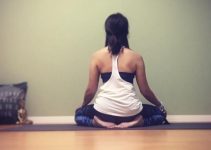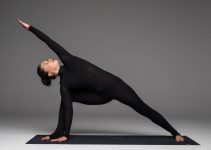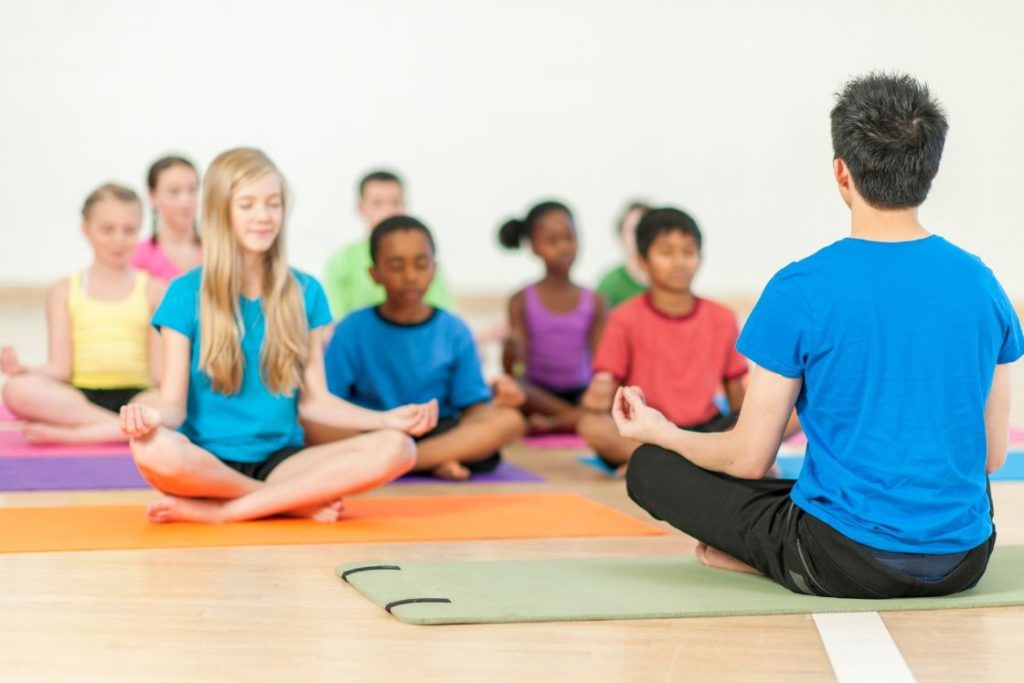
Well, it’s even in the saying that “all work and no play makes Jack a dull boy.” As much as education is necessary for the child, physical activity like yoga is equally important. As studying help kids develop meaningful intellectual insights, enriching yoga develops their mind and body able enough to generate actions from the insights.
Certain activities that are an absolute red flag to kids include gym and weightlifting, heavy strength-based sports, highly competitive sports and martial art-related activities. However, there are kids who have been doing quite well in the aforementioned areas, but those are exceptional scenarios.
You generally don’t want to involve your kid in activities requiring advanced level strength, endurance and flexibility. Such activities pose higher chances of injury to the young and developing tissues in your kid’s body. Even specializing in a particular sport in the early years will limit your kid’s mind and body abilities to a particular structure. You don’t want that.
Moreover, you definitely don’t want activities that increase mental anxiety, peer pressure, and aggression in yoga kids. It should be an absolutely fun activity. Inculcating different yoga exercises in daily routine can increase the versatility of your kid’s mind and body.
Benefits of Yoga for Kids
Yoga happens to be the perfect fit to serve the requirements of kids and their growing minds and body. Practising yoga nurture your kids’ growth with many wondrous benefits:
- Yoga boosts the production of Human Growth Hormone (HGH) and Growth Hormone-Releasing Hormone in childern.
- It enhances musclar stregnth and reduce chances of musculoskeletal injury
- Yoga gives hyperactive mind and body of a kid a proper rest.
- Practicing yoga can build a flexible and agile body
- Yoga regulate hormonal activities during growing years
- Curate the efficiency of bodily functions important to growth like, metabolism, nutrients absorption, respiration, digestions, blood flow, nervous transmission and excretion.
- Improve cognitive abilities and memory of kids
- Develop healthy levels of confidence and self-esteem
- Generate physical consciousness and awareness.
- Learn the importance of patience, concentration and focus
- Enhance determination, commitment and will power
Isn’t yoga difficult for kids?
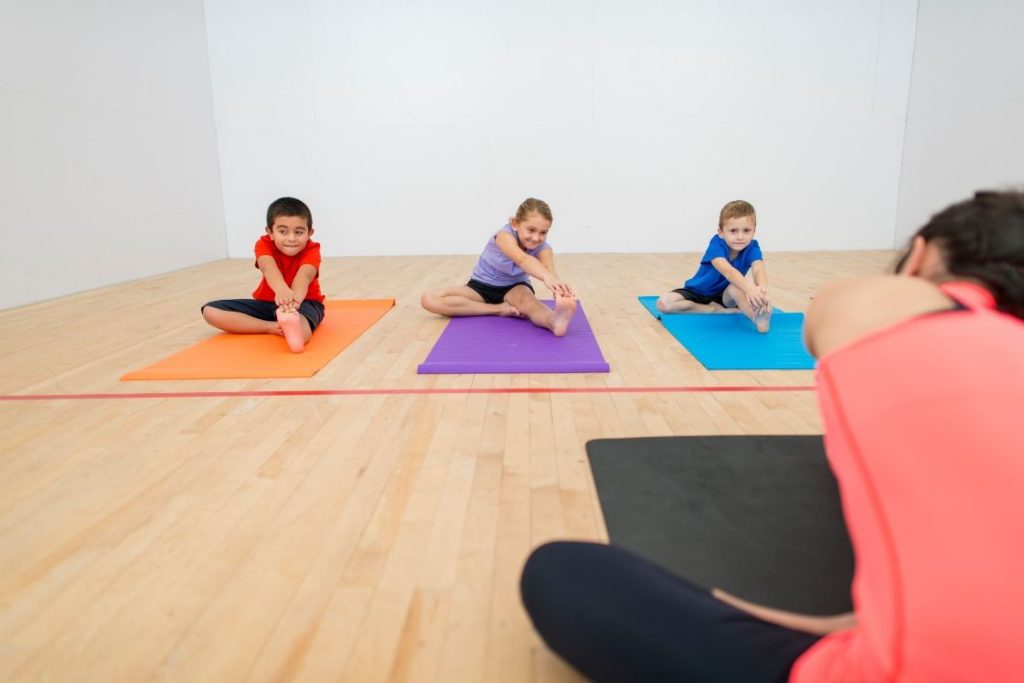
Yoga is an extensive practice with many styles and different poses. Even one single pose in yoga has different ways to perform, modifications and variations. And above that, a handful number of yoga props. This makes yoga applicable for any person at any age including preschoolers and school-aged children.
It is true that yoga poses can be quite physically challenging at times requiring advanced level muscle strength, flexibility, endurance, control and awareness. So yes, such advanced yoga styles like vinyasa and hot yoga will be quite difficult for kids and maybe even injury prone.
However, the point is such yoga poses are not meant for kids, so children should not concern themselves with such poses. Yoga has a great variety of poses that are easy for beginners and kids. Poses that despite being easy do not compromise on the benefits.
As a matter of fact, the difficult poses are mostly for muscle enhancement and body toning. The poses with maximum mind-body development-related benefits are easily doable for kids and beginners. And that is precisely the purpose of this article to introduce you to such poses.
How yoga develops the body of a kid?
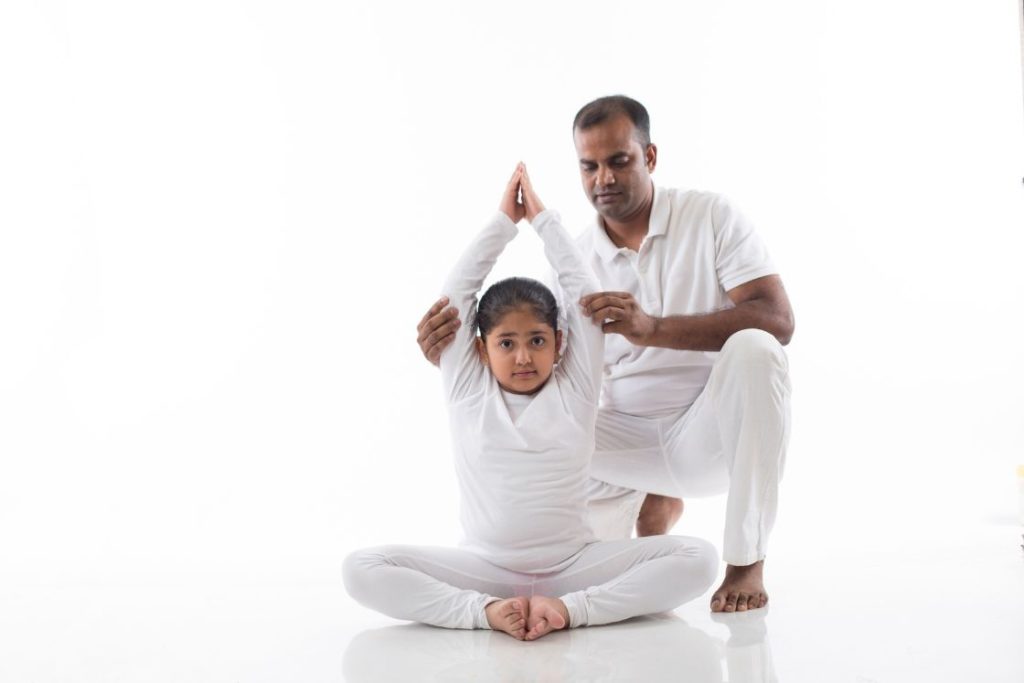
Yoga exercises applicable for kids have very generous physical benefits. These benefits are the results of benefiting different bodily functions.
1. Yoga stimulates nervous system
Some of the yoga poses for kids have a very stimulating effect on the Central Nervous System and the Peripheral Nervous System. The static holds and slow tension contained movements used in yoga poses optimise the neuron firings along the neural pathways. This essential benefit generates most of the positive nervous functions.
The evidence of yoga practice effect on children’s nervous sysmtem indicates improved motor skills and cognitive abilities, reducing stress, and better electrical response by autonomic nerves to speedy data processing in the brain and body.
2. Yoga enhances respiratory efficiency
Yoga poses, especially pranayama breathing, make the practice brilliant to your kid’s respiratory system and organs. Gentle yoga poses along with breath awareness help kids optimise the contraction and relaxation of the respiratory passages and lung airways. It clears these passages’ obstructions like mucus, phlegm, and allergens, and improves the ability of the lungs to intake oxygen.
The respiratory benefit will provide sufficient oxygen to the body. Sufficient oxygen will maintain the good health of the muscles and act as fuel to many critical chemical reactions vital to mind-body growth.
3. Yoga optimizes cardiovascular functions
Yoga poses can be a very generous cardio exercise for your kids. It can help your kid improve their cardiac input and output, lower levels of body fat, heart rate and blood pressure.
These cadio benefits combined will prove elemental in the blood circulation of the body, and thus consequently, development and growth of muscle and organ tissues all over the body.
Yoga exercise also improve the health of arteries and veins, which will also promote effective blood detoxification (especially of the metabolic waste.)
4. Yoga can balance Hormonal activities
When childern go through their developing years, their body goes through high levels of fluctuation in hormones (ages 6 to 12). An abnormal fluctuation can interfere and even hinder their growth, as the hormones play a vital catalytic role in biological growth.
Yoga practice can synchronise and improve the interactions between neurological activities and endocrine activities, which eventually stages a balanced hormonal condition.
Children practicing yoga have better regulation of many vital hormones, like the HGH for biological growth of tissues, stress managing hormones, digestion enabling hormones, nutrients synthesizing hormones, hunger managing hormones, sleep-enhancing hormones, and so on.
5. Yoga boosts metabolism
For the biological growth of the physiology of mind and body, kids need nutrients. But sometimes even providing the kids with all the quintessential nutrients, the growth can be incomplete. This is mostly because of the fact that their body lacks the necessary rate of nutrients management.
This is precisely where the benefits of yoga on metabolism leave an impression. Yoga poses for digestion have a high efficacy in improving the metabolism rate of a kid. The increased metabolism rate ensures that all the developing cells in your kid’s body undergo the necessary chemical reactions to absorb nutrients, transport nutrients, synthesize nutrients and utilize nutrients.
How yoga develops the mind of a kid?
The impact of yoga on kid’s minds is the other pivotal area that deserves focus. The practise of yoga has a significant impact on the human brain and the entire neurological system. And when these benefits are applied to a kid’s brain, which happens in the process of development, the changes not only become permanent but evolve over time to yield new intellectual abilities.
Practising yoga impacts different areas of the kids brain unlocking many dormant intellectual abilities. It is not uncommon for kids practising yoga to have a higher sense of emotional understanding, compassion and controlled stress response (by stimulating the Hypothalamus-Pituitary-adrenal Axis).
Yoga stimulates the prefrontal cortex, also enables yoga-practising kids to install a range of self-restraining and self-disciplining behaviours, which prove highly beneficial in terms of career, health and academics. The practise of yoga poses also improve mind-body awareness and consciousness in kids, which generally take years to develop otherwise. The awareness and consciousness will help kids grow into adults with a better understanding of reality.
Easy But Beneficial Yoga Poses for Kids
Train your kid with a yoga routine that is not just easy, but also is effectively diverse in terms of the benefits. A comprehensive yoga routine will help your kid grow into a healthy and productive individual.
1. Tree pose
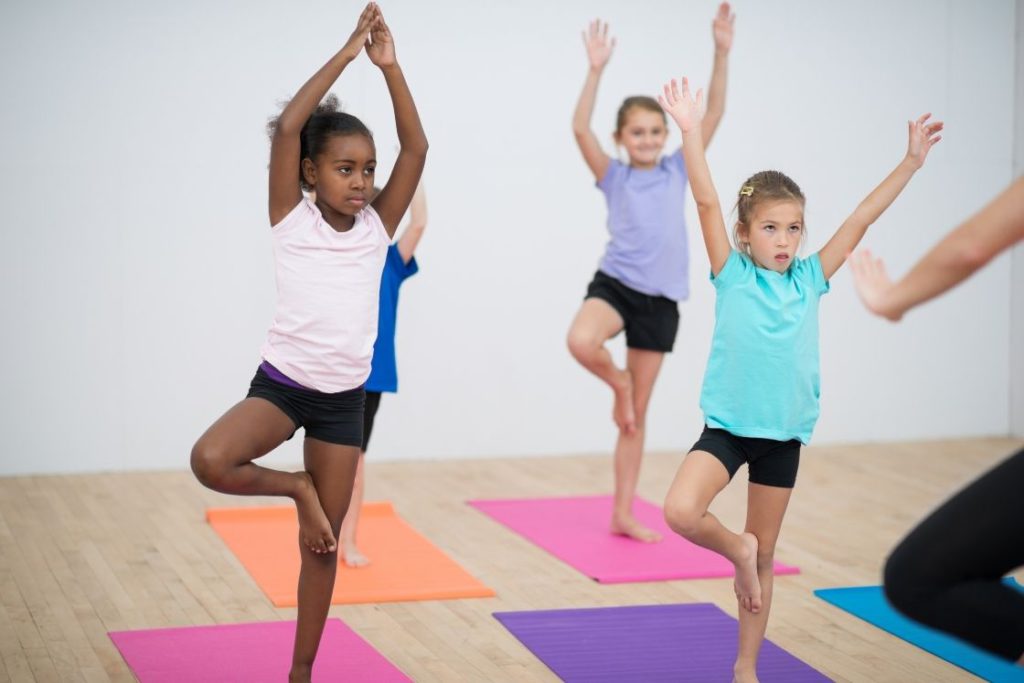
Tree pose is good for the development of overall body muscles and peripheral nerve functions. It improves balance, strength, concentration, and endurance in children.
- Stand in a mountain pose
- Shift bodyweight to the right leg and lift the left foot off the ground
- Balance the whole body on the right leg
- Rest the left foot against the inside of the right thigh.
- Raise both hand overhead, and join the hands in Anjali mudra exactly over the head.
- Breathe steadily and hold the pose for a minute
- Balance on left leg
Note: To develop the initial balance in kids, this pose can be practiced against a wall. or a chair can be placed as a support under the rested knee.
2. Warrior II pose
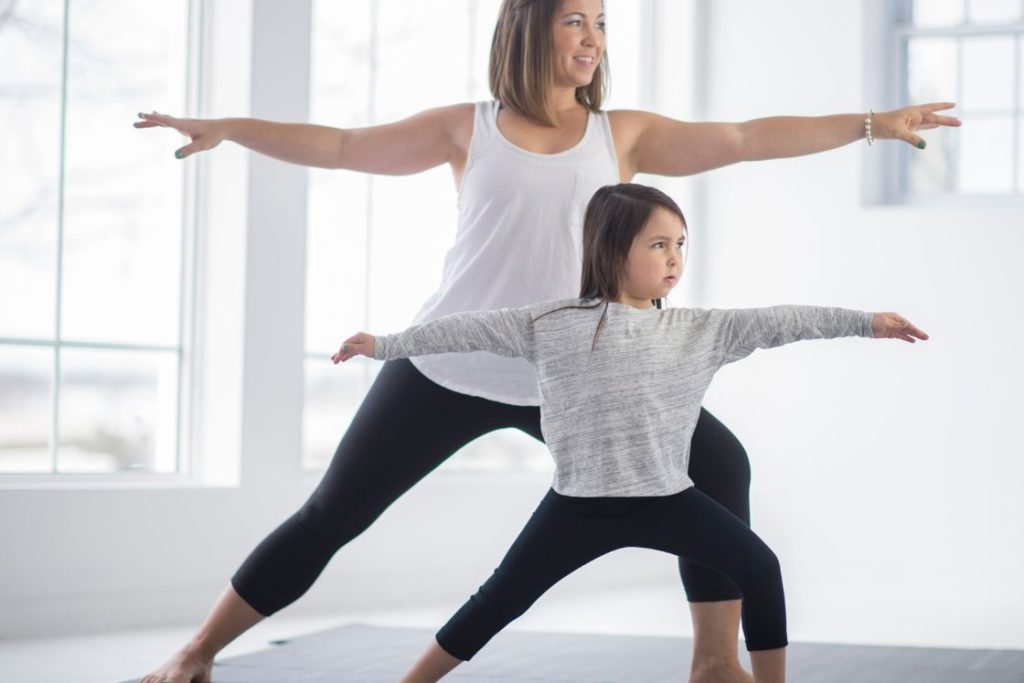
Warrior 2 builds strength of the muscles, especially of kids legs, groin, hips, lower abs, arms and shoulders. This pose too has benefits for your nerves, blood circulation and balance.
- Stand with legs wide apart, 3-4 feet.
- Turn right foot 90 degrees to the right, and left foot 45 degrees to the right.
- Lunge to the right. by shifting the bodyweight towards the right leg
- Keep lunging till the right thigh is parallel to the ground, and the left leg stretched out straight.
- Keep the upper body centered and not forced over the right leg.
- Extend both hands straight outwards at either sides of the body, at shoulder level.
- Hands should be parallel to the ground.
- Hold the pose for 5-7 breaths and repeat the pose on the other side.
Note: The lunge and stretch in the legs need to be felt while practising and can be increased or reduced as per requirement. The leg balance and stretch lays the foundation of the pose, misjudging the feet placement and stretch level can result in injury.
3. Garland pose to Bound Angle pose
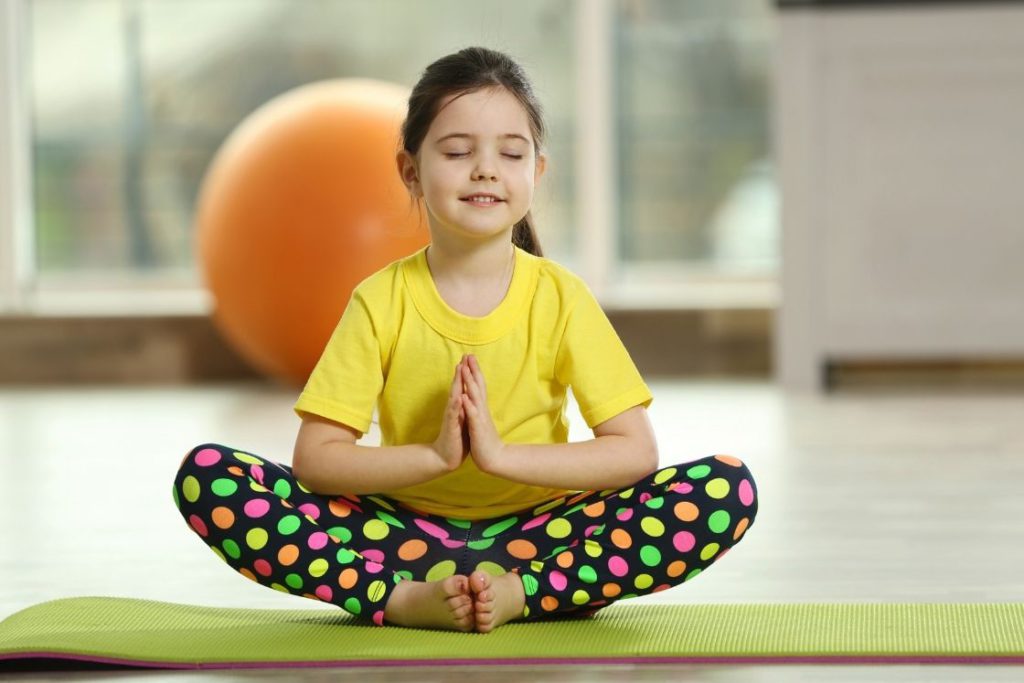
Garland pose for kids builds strength in the leg muscles and improves the leg muscle contractions that improve detoxification by enabling blood flow in veins. It also benefits kids metabolism and digestion. This pose also supports bowel movements, especially in the intestines. The bound angle pose will enhance blood flow, boost digestion, relieve stress and improve hormonal activities
- Stand straight in a mountain pose.
- Bend the knees and come down in a squat.
- Lean the upper body slightly forward and extend the buttocks backward to counter the forward lean.
- Join the hands in Namaskara mudra in front of the chest.
- Keep squatting all the way down till sitting down in a full squat.
- Let the knees slightly extended outward, and maintain the forward leaning.
- Breathe steadily and hold the pose for a minute.
- Then sit back on the sitting bones.
- let the Knees open at the sides and fall toward the ground at their respective sides.
- Join the soles of the feet and clasp the hands around the feet.
- hold the feet against the groin.
- Still maintain the slight forward tilt in the upper body.
- Flap the knees like wings, but slowly and steadily.
- Continue this pose for about 20 seconds.
Note: The garland pose part of this sequence can be practised separately, especially as a preparation to relieve the bowel. Drink a warm glass of water and sit in the garland pose for a couple of minutes before going to the bathroom. It will make your bowel passage smooth.
4. Half Lord of the fish pose
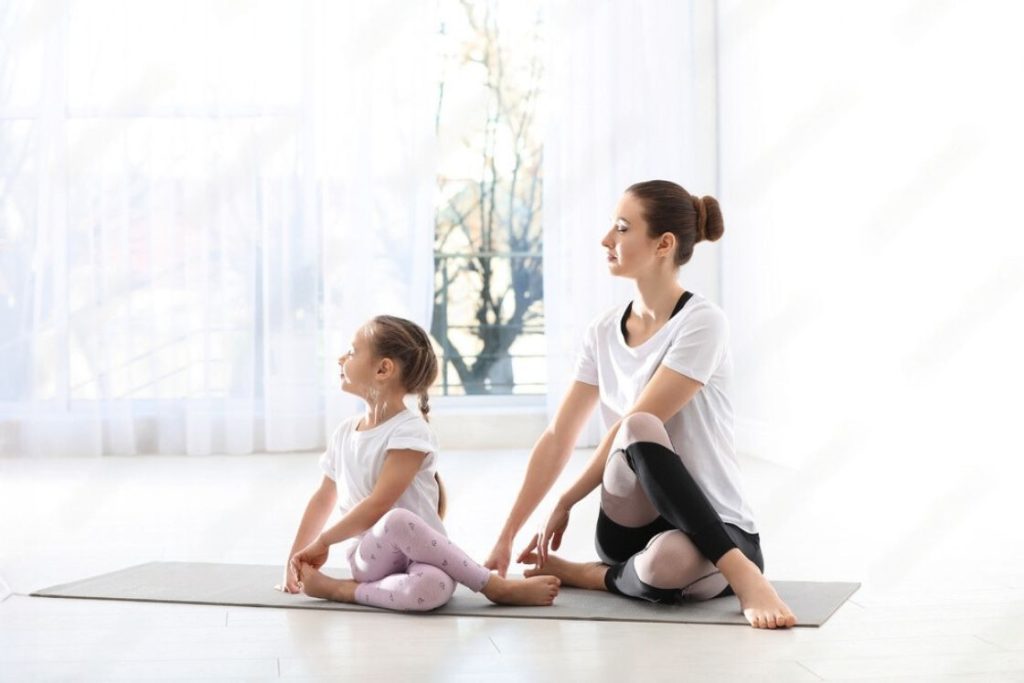
Half lord of the fish pose is prominent for its spinal twist, which will be both fun and relaxing for kids. This pose improves the functioning of the Central Nervous System and increases metabolism.
- Sit in a staff pose
- Bend and fold up the right knee
- Take the right foot to the left side of the left knee.
- Lock the right foot against the left knee.
- Hold the right knee with the left hand
- Keeping the upper body straight and twist the torso and turn to the right by 90 degrees.
- Place the right hand on the ground behind the sitting bones.
- Look towards the right shoulder.
- Breathe in and out steadily.
- Hold the pose for 5-7 breaths and repeat the twist to the right.
Note: This pose can also be performed on a chair. Sit on a yoga chair and stack the knees over one another, and perform the twist.
5. Thunderbolt pose
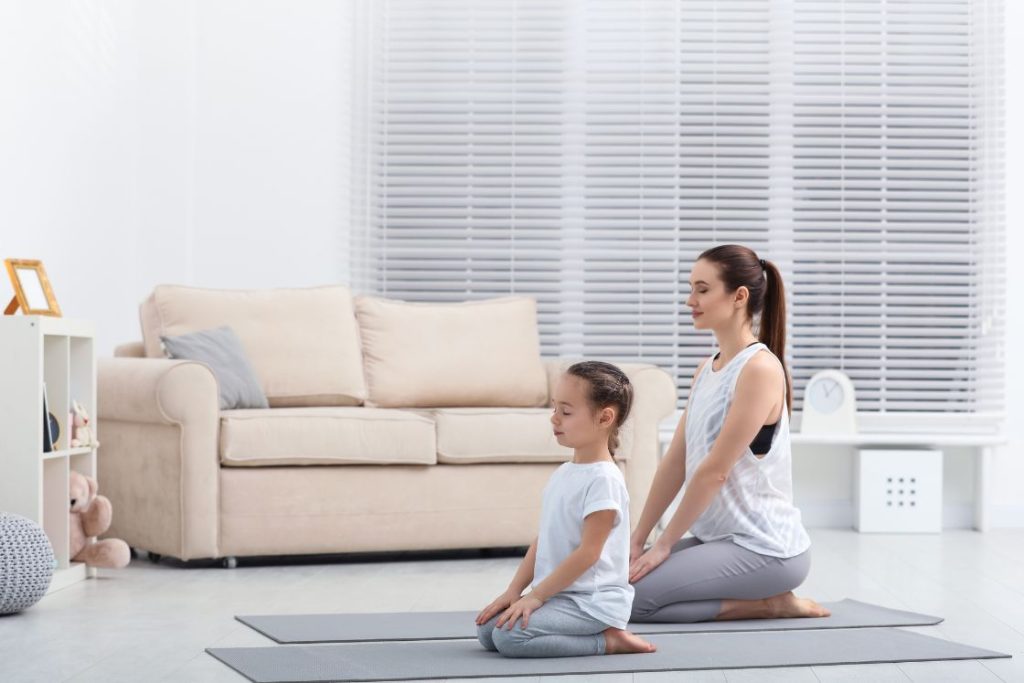
Thunderbolt pose is typically a benefactor of digestion and metabolism. Kids can strike this pose after meals for better passage of food in the digestive tracts and then better digestion. Thunderbolt pose can also be used to relieve gas, improve blood flow and balance hormonal activities.
- Kneel down on the floor
- Join your knees and thighs.
- Fold your knees and bend back your thighs to sit on your heels.
- Keep your upper body straight and maintain length in your spine.
- Keep the shoulders pressed down.
- Place your hands on your knees.
- Breathe steadily and sit in this pose for 3-4 minutes.
Note: This pose can be normally practiced at any time of day, while performing other activities like reading or watching television. This pose can also be used to focus in meditation.
6. Extended puppy pose
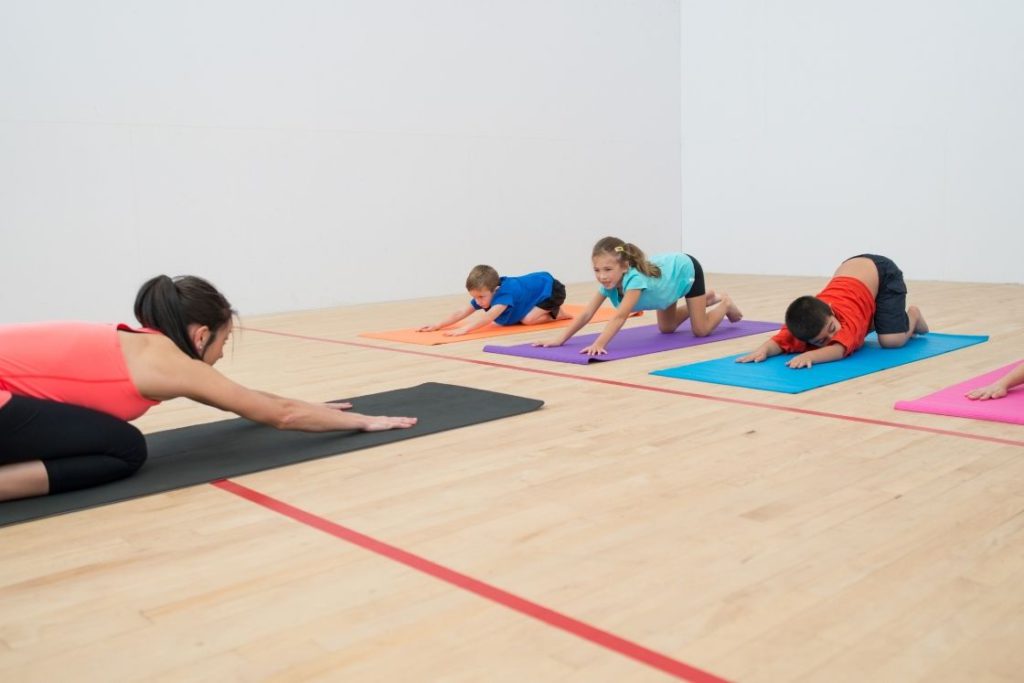
Extended puppy is a wonderful stress reliever and relaxing yoga pose for kids. This pose increases the flexibility of upper body muscles, hip muscles, pelvic floor and thigh muscles. The extended puppy pose improves nervous functions, cardiovascular functions, respiratory functions, metabolism and hormonal activities. This pose will also be fun to perform. For your kid’s growth, this pose can be very well a complete pose.
- Sit in thunderbolt pose.
- Raise both the hands overhead and bend forward to touch the chest with the knee.
- Touch the head to the ground and extend the arms and the upper back further in front.
- Push down with the chest towards the ground and stretch your spine
- This is child’s pose and hold in this pose for 30 seconds and breathe relatively deep.
- Look in front, putting your chin to the ground, and slide in front, lifting up your buttocks bringing your hips over your knees.
- Consciously push downward with your body creating a nice curving stretch in your spine.
- Hold the pose 7-10 breaths.
- Return to child’s pose hold it for another 10-15 seconds and release.
Note: Use a yoga wheel to slide forward to get into the extended puppy pose. This yoga wheel will not only make the sliding easier and injury-free but also feel like a fun activity to a kid.
7. Cat Cow Pose
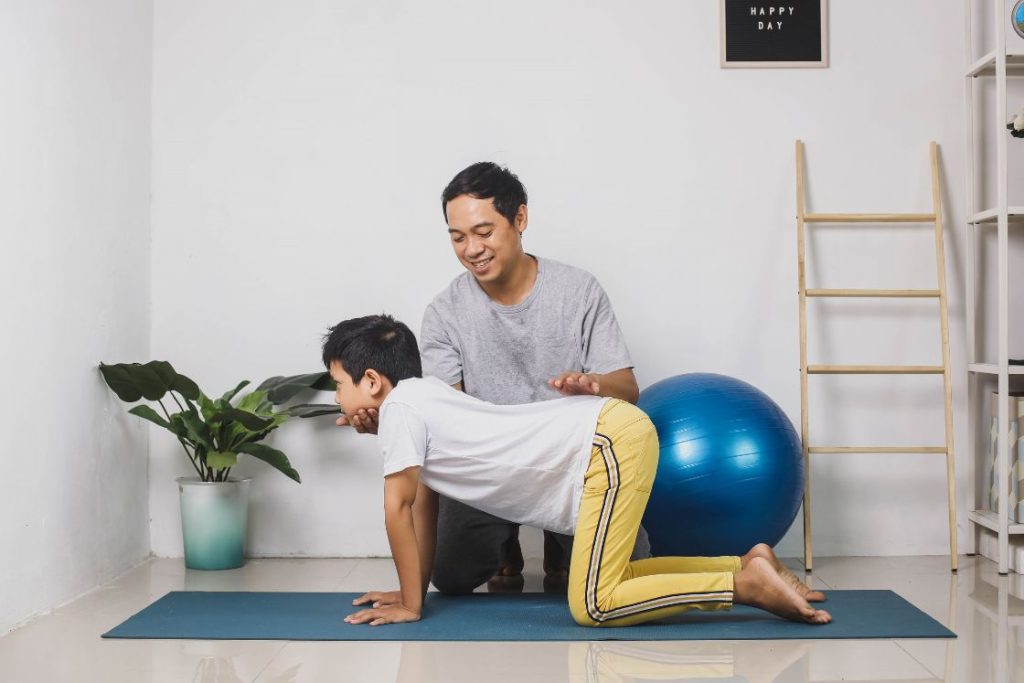
Cat cow pose will help your kids improve their spine flexibility and the blood flow and nervous functions along the spine. This pose also benefits the abdominal organs, especially in stimulating them for digestion, metabolism and hormonal functions.
- Get down on all fours, your hands and knees.
- Keep your knees hip width wide.
- Wrists should be below your shoulders and knees should be below your hips.
- Extend your feet outward, placing the top of your ankles and toes to the ground.
- Inhale and drop your belly down.
- Roll your shoulders back, and press them down.
- Keep your hands straight, and neck free from your shoulders.
- Look up.
- Exhale and curl up your belly against your spine, and roll your shoulders forward.
- Look down.
- Repeat this pose for 5-7 times.
Note: Before leaving this pose, get into a plank pose to give a boost to physical strength and endurance. To get into plank pose simply lift your knees off the floor and extend straight backwards, and hold the body still for about 30 seconds.
8. Cobra pose
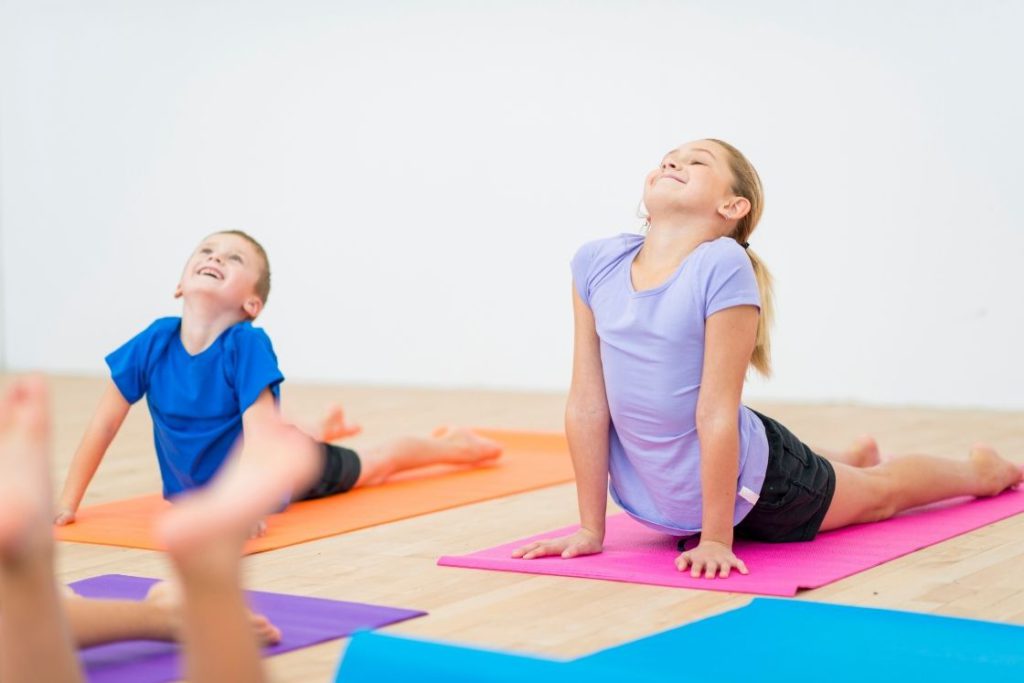
Cobra pose is best to keep the spine healthy. This pose stimulates the CNS, generating many of yoga’s typical mental benefits. This pose is also very effective in enhancing cardiovascular and respiratory functions.
- Lie on the front of the body
- Place both the hands by the side of the chest, against the floor
- Keep the legs hip width apart.
- Push against the floor and arch up the spine, and thus the body.
- Arch up till the hands are straightened, and head and chest faces the front.
- Push out the chest and press down the shoulders.
- The arch in the spine should be even throughout the spine.
- Keep the pelvis touched to the ground.
- Hold the pose for 5-7 breaths.
Note: The head can be slightly tilted backwards, this pose must not be performed by a kid without adult supervision, since it deals heavily with the spinal cord.
9. Bridge Pose
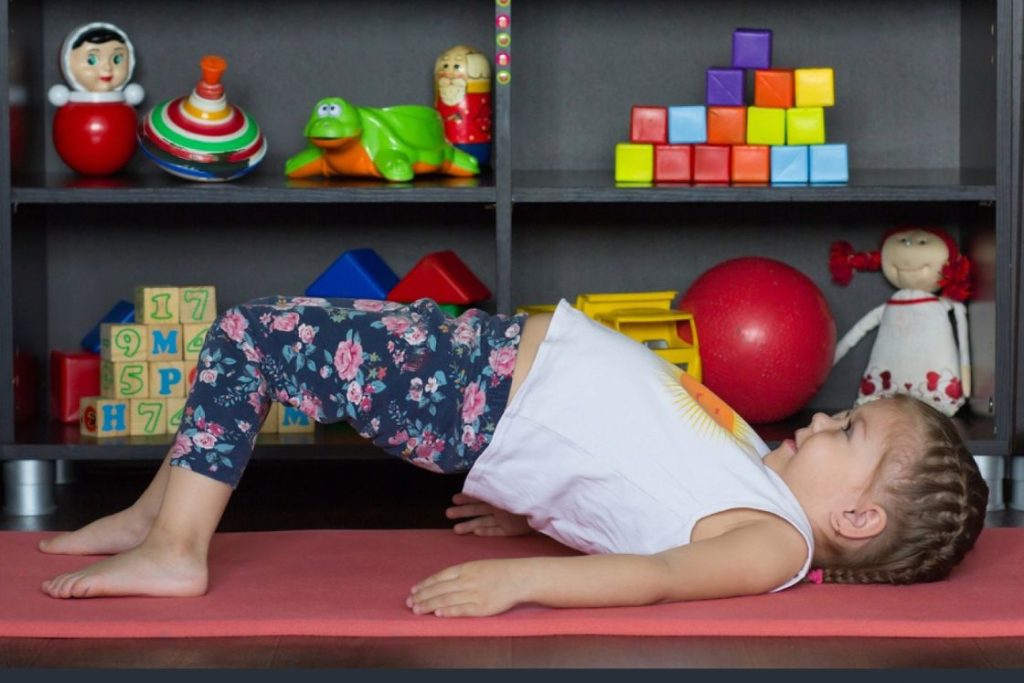
Bridge pose is both a relaxing and building pose. This pose improves flexibility of the spine, and the durability of muscles. It is great for relieving anxiety and stress. Also, it improves hormonal and cardiovascular functions in children.
- Lie supine on the ground
- Keep the legs and feet hip width apart.
- Place the hands by the sides of the body.
- Push against the ground, lift your buttocks off the floor and push the pelvis toward the ceiling.
- Keep pushing up till your pelvis comes to the level of your knees.
- Push your chest towards your chin.
- Hold the pose for 5-7 breaths.
Note: This pose too should be performed under the supervision of an instructor, as it has slight potential to injure the neck region. Also strap the thighs together to prevent the knees from extending outward.
Can yoga causes injury in kids?
Yoga poses are mostly known for their restorative and healing nature. However, it is still not uncommon for parents to worry about their kid’s safety. Because truth be told there are incidents of people picking up an injury from yoga. But then again, such is the case with any exercise in existence. What one must focus on, is that the rate of injury with yoga is much less, when compared to other mainstream exercises.
This means that with yoga your kid will face far less chances of getting injured. Further, it must be noted, that the injuries are not caused by the intensity or the nature of the yoga exercise itself, but the noncompliance with the protocols of practice. If a kid’s yoga training is supervised by an experienced instructor, provided with sufficient rest and nutrition and guided by parents, the chances of injury will be next to nil.
